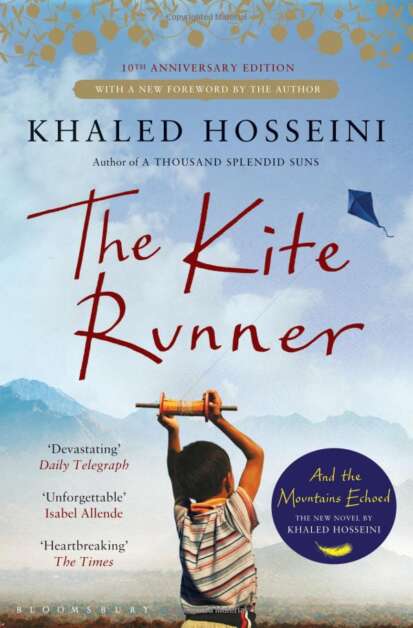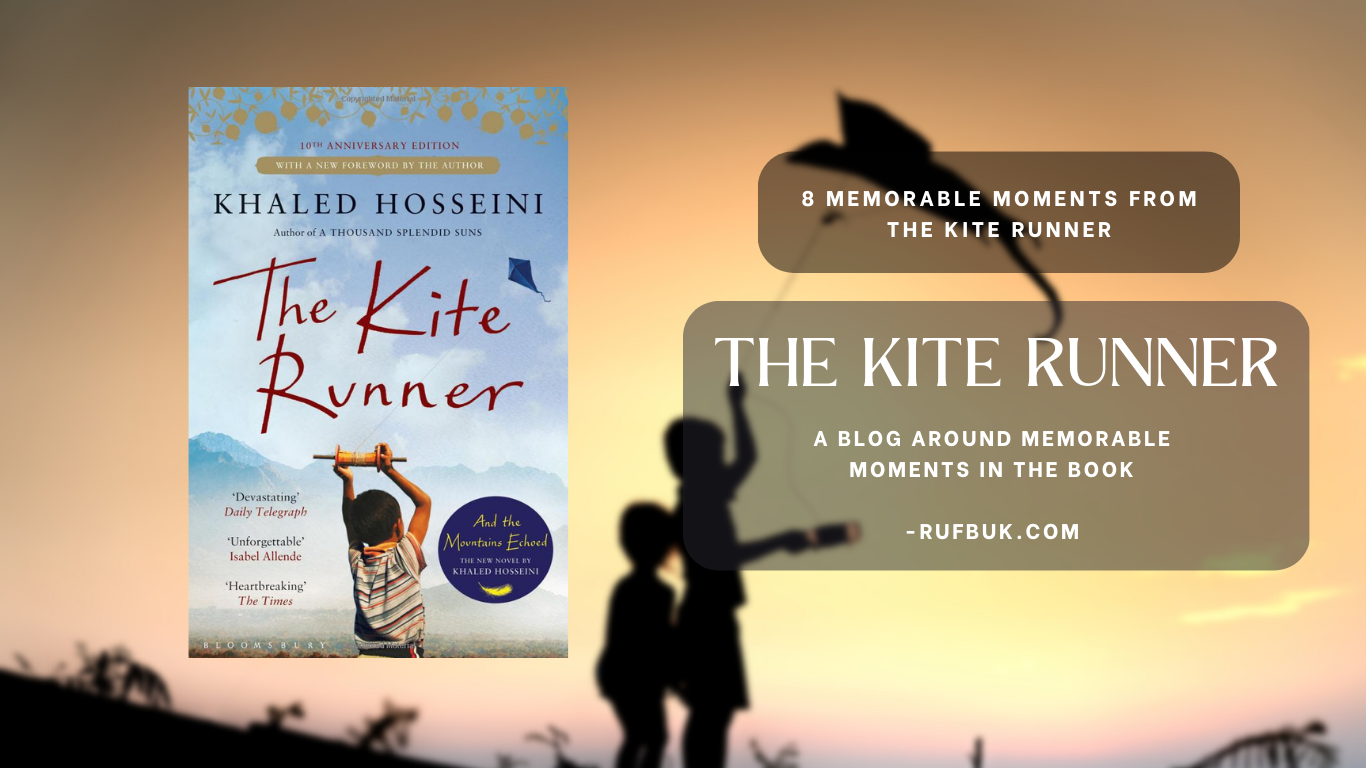Table of Contents
The Kite Runner is a book written by Khaled Hosseini that was published in 2003. Since then, The Kite Runner has remained one of the most memorable books of our generation. It had such a significant impact on its readers that the author Khaled Hosseini had to spend the next decade defending his writing from criticism. We have collated some of the most memorable moments from the book. We hope the moments will inspire your thoughts about the book and the different interpretations you might have. The book is a mix of past and present and has 8 memorable moments. Let us look at them.
The Kite Runner – Book Details
| Book Name | The Kite Runner |
| Author | Khaled Hosseini |
| Genre | Fiction |
| Published | 2003 |
8 memorable moments from The Kite Runner
1. Hassan’s sacrifice of the kite for Amir
Hassan sacrifices himself for Amir by catching the winning kite for him during a kite-fighting tournament. This act solidifies their friendship and reveals Hassan’s loyalty to Amir, despite being mistreated by him.
The kite-fighting tournament is a significant event in “The Kite Runner.” During the tournament, Amir and Hassan are running the last kite of the day. After Amir cuts the last kite, Hassan goes to retrieve it for him. Hassan is confronted by Assef and his friends, who physically attack him for being a Hazara. This event is significant because it demonstrates the racial tension and discrimination present in Afghanistan at the time. It also highlights the friendship and loyalty between Amir and Hassan, as Hassan sacrifices himself for Amir even in the face of danger. The kite-fighting tournament and Hassan’s sacrifice serve as a turning point in their relationship and shape the course of events in the novel.
2. Baba and Amir’s relationship
Baba and Amir have a complex relationship characterised by love, frustration, and misunderstandings. Baba is a successful businessman and a respected figure in Afghan society, but he is often distant and strict with Amir. Amir struggles to live up to Baba’s expectations and feels a sense of inferiority compared to his larger-than-life father. Despite this, Amir deeply loves Baba and admires his strength and generosity. Baba’s secrets are revealed as the novel progresses, and Amir understands and appreciates his father in new ways. Through their relationship, the novel explores themes of father-son relationships, the search for identity, and the complexities of love and forgiveness.
3. Sohrab’s arrival changes Amir’s life
Sohrab’s arrival changes Amir’s life in several ways. Sohrab is the son of Hassan, Amir’s childhood friend and half-brother, who the Taliban murdered. When Amir finds out about Sohrab’s existence, he feels a sense of obligation to bring him back to the United States and raise him as his own son. This leads to Amir’s return to Afghanistan, where he rescues Sohrab from a Taliban-run orphanage.
Sohrab’s arrival forces Amir to confront his past and the guilt he feels for not protecting Hassan from Assef’s attack. Raising Sohrab also helps Amir to heal from his own traumatic experiences and to develop a sense of purpose and responsibility. Through his relationship with Sohrab, Amir learns the true meaning of love and redemption and begins to make amends for his past mistakes. The arrival of Sohrab transforms Amir’s life and helps him to find a sense of closure and peace.
4. Amir’s return to Afghanistan
In “The Kite Runner,” Amir returns to Afghanistan after many years of living in the United States. This return is motivated by his desire to rescue Sohrab, the son of his childhood friend and half-brother Hassan, from a Taliban-run orphanage.
Amir’s return to Afghanistan is a journey of self-discovery and redemption. It forces him to confront the memories and guilt he has been carrying with him since his childhood. He sees the changes in the country and the people he once knew and experienced the harsh reality of the Taliban’s regime. Through his interactions with Sohrab and others, Amir begins to understand the impact of his past actions and the weight of his guilt.
Amir’s return to Afghanistan represents a turning point in the novel and serves to bring resolution to his past. It provides an opportunity for Amir to make amends for his past mistakes and to begin a journey of healing and redemption.
5. The confrontation between Amir and Assef
In “The Kite Runner,” the confrontation between Amir and Assef is a pivotal moment in the novel. The confrontation occurs after Amir rescues Sohrab from a Taliban-run orphanage and confronts Assef, one of the Taliban leaders. The confrontation is a manifestation of the long-standing enmity between Amir and Assef, who had previously attacked Hassan, Amir’s childhood friend and half-brother.
The confrontation between Amir and Assef is a physically and emotionally charged scene. It represents the culmination of the themes of guilt, redemption, and the consequences of past actions that are woven throughout the novel. Through the confrontation, Amir can come to terms with his own guilt and make amends for his past mistakes. The scene serves to bring closure to the events of Amir’s childhood and serves as a turning point in his journey of redemption.
6. Sohrab’s rescue
In “The Kite Runner,” Sohrab’s rescue is a defining moment in the novel. Sohrab is the son of Hassan, Amir’s childhood friend and half-brother, who the Taliban murdered. After learning about Sohrab’s existence, Amir returns to Afghanistan to rescue him from a Taliban-run orphanage.
The rescue of Sohrab is a dangerous and emotional journey for Amir. He must navigate the changing political landscape of Afghanistan and confront the Taliban leaders who are holding Sohrab captive. The rescue represents a turning point in the novel, as it allows Amir to come to terms with his past and to make amends for his past mistakes. Through his actions, Amir learns the true meaning of love and redemption.
The rescue of Sohrab is also a key moment in the development of the father-son relationship between Amir and Sohrab. It marks the beginning of Amir’s journey as a father figure to Sohrab and sets the stage for the two of them to heal from their own traumatic experiences. Sohrab’s rescue serves as a powerful example of the transformative power of love and redemption.
7. Rahim Khan’s death
In “The Kite Runner,” Rahim Khan’s death is a poignant moment in the novel. Rahim Khan is a close friend of Baba and a mentor to Amir. He serves as a sounding board for Amir and provides guidance and support throughout the novel.
Rahim Khan’s death is a turning point in the novel. It serves to emphasise the fleeting nature of life and the importance of making amends for past mistakes. Through his death, Rahim Khan’s wisdom and influence continue to guide Amir on his journey of redemption. The death of Rahim Khan serves as a reminder of the power of friendship and the importance of cherishing those we love.
Rahim Khan’s death is also significant in the context of the novel’s larger themes. It underscores the themes of guilt, redemption, and the consequences of past actions woven throughout the story. Through the death of Rahim Khan, the novel emphasises the importance of facing the past and making amends for mistakes in order to find peace and closure.
8. The realisation of Hassan being Amir’s half-brother
In “The Kite Runner,” the realisation of Hassan being Amir’s half-brother is crucial in the novel. The realisation comes after Amir learns the truth about Hassan’s parentage from Rahim Khan. Up until this point, Amir has been struggling with guilt and regret over his past actions towards Hassan, his childhood friend.
The realisation of Hassan being Amir’s half-brother is a turning point in the novel, as it forces Amir to confront the truth about his past actions and to understand the true nature of his relationship with Hassan. It deepens the themes of guilt, redemption, and the consequences of past actions woven throughout the story. Through this realisation, Amir begins to understand the weight of his guilt and the importance of making amends for his past mistakes.
The realisation of Hassan being Amir’s half-brother is also significant in the context of the novel’s larger themes. It serves to highlight the themes of identity, family, and the complexity of relationships. It underscores the idea that family bonds are often complicated and that the truth about one’s relationships with others can be challenging to understand fully. The realisation of Hassan’s parentage adds depth to the novel’s relationships and emphasises the power of love and family and the importance of facing the truth.
Some FAQ’s from The Kite Runner


What is the setting of The Kite Runner?
The setting is Afghanistan, from the late 1970s to the early 2000s.
Who is the main character and the central conflict in The Kite Runner?
Amir is the main character. The central conflict is Amir’s guilt and longing for redemption for not standing up for his best friend Hassan, who was tragically abused.
What is the significance of kite flying in The Kite Runner?
Kite flying symbolizes freedom, unity, and hope in Afghanistan. It also serves as a recurring motif in the novel, representing the central themes of friendship, guilt, and redemption.
What is the relationship between Amir and Baba in The Kite Runner?
Amir and Baba have a strained relationship due to Baba’s disappointment in Amir, who he sees as weak and lacking courage.
What is the meaning behind the title The Kite Runner?
The title refers to a kite-fighting tournament in Afghanistan and symbolizes the friendship and competition between Amir and Hassan and Amir’s quest for redemption.


Bishal Saha is a Bibliophile, Writer and also has a keen interest in Computer Science. He is very fond of Literature and Technology. Bishal set out to gain more expertise and ended up carving out a niche as a Part-time Freelance Writer.
Bishal Saha specializes in Content Writing, SEO Writing, Creative Writing, Article Writing, and Proofreading to maximize the reader’s attention and catapult the product/services. He is also a Book Coach.

